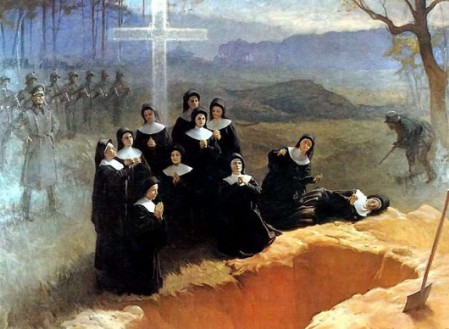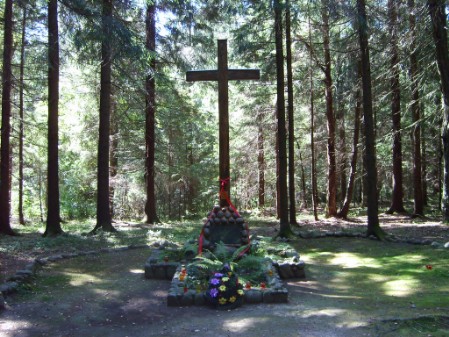Content, narration, message, realization

Introduction
This event and the scale
of the sacrifice of the Sisters of Nowogródek have no equal in the world during
World War II. Pope John Paul II in 2000 proclaimed eleven Sisters of Nazareth
as blessed martyrs. Despite these facts, the story of the Sisters' sacrifice is
little known to Polish society and completely unknown to the world. Our film
aims to give a faithful testimony and widely propagate the Christian concept of
“love thy neighbor” and the martyrdom of the Sisters of Nazareth, which is such
an extremely enriching piece of Polish history and Catholic tradition.





Narration
King Jagiello and Sophia of Halshany, the founders of the Jagiellonian dynasty, were married in the Nowogrodek basilica commissioned by Grand Duke Witold. The great Polish poet Adam Mickiewicz was baptized here in 1799. And from this church, on April 31, 1943, eleven Sisters of the Holy Family of Nazareth set out to give their lives for 120 hostages. The nuns were women with different characters, but, in every part of the story, their shared trait is repeated: a deep and passionate faith that gives strength to the spirit, stimulating their compassion and their willingness to help those in need. Eyewitnesses say they walked to meet their death without hesitation, praying with hope and love.
The movie opens with a dramatic scene of the arrest of the 120 hostages in July 1943. We follow these events from the point of view of 11-year-old Alice, who loses her grandparents – her last familial support after her parents’ deaths – because they are among those taken hostage. The Sisters welcome Alice and surround the orphan with love and care. And prompted by their prayers, they make the decision to resolutely sacrifice their lives for the lives of the captives.
Mother Superior, Sister Stella, presents this offer to the ruthless Gestapo commander in Nowogrodek. From the point of view of the SS officer, the offer is absurd. Why should he forgo the execution of 120 hostages as punishment for the Home Army partisans’ actions? Failure to execute them could mean his own trial, a punitive reassignment to the Eastern Front and demotion. And yet, after talking to Sister Stella, the Gestapo commander agrees. The spiritual strength of the Mother Superior overwhelms him, changing his will – probably not fully consciously – against his instinct for self-preservation. The SS officer sends all 120 hostages into forced labor in Germany and gives the order to murder the Sisters.
He then takes part in the execution, killing Sister Stella himself.
Was he trying to free himself from her powers? That turns out to be impossible. A dark, nagging emptiness arises within him: a feeling of the nonsense of existence, and ultimate confusion and despair, which he tries to drown out with alcohol. He would be finally expelled from the SS and become a wreck of a man. Alice is the silent witness to the fall and eventual suicide of the Gestapo commander.
In the forest near Nowogrodek, the metaphysical triumph of faith is in the works for the eleven Sisters of the Holy Family of Nazareth, who set off to meet their Creator with dignity and sacrificial peace. The climax is a phenomenal scene without words: a forest immersed in the rising sun, the faces and eyes of the Sisters as they walk fearlessly to meet their death, the faces of the SS NCOs astonished by the nuns’ incomprehensible power, birds silenced after the first shot, the bodies of the martyrs falling, the fading light in their eyes, the mighty singing of the choir that welcomes the Sisters into the Kingdom of Heaven.
Later, through Alice’s eyes, we see the 120 hostages leaving to work in Germany, saying their farewells to their families. It’s made clear in the postscript they all survived and returned to their homes.
The glorious conclusion of the earthly fate of the martyrs of Nazareth is their beatification by John Paul II in 2000 in Rome. Documentary film footage from this ceremony will close the saga of the Sisters’ earthly and metaphysical journey.
The Message
A life sacrificed for the lives of others: this is the movie’s main message, but also the message of Christianity, deeply etched in the history of the Polish nation. The idea is also to show the closeness of the several nations who lived on this land and shared the tragic fate at the hands of its occupiers. The homage paid cooperatively by artists-representatives of several countries to the Sisters of Nazareth will be a joint call for reconciliation between peoples as brothers and sisters, the children of one God.
America’s Polish diaspora, which draws its strength from Polish culture and history, will play an important role in the making of this movie. The sacrifice and the Christian model of the Sisters of Nazareth is a strong magnet in the memory of Poles in the United States. The idea of making the film fits in with the concept of building and promoting the historical policy of the Polish state, taking into account the value of truth and the importance of Catholic tradition.
The Formula of the Narration
Telling the story of the
Sisters of the Holy Family of Nazareth from the point of view of an 11-year-old
girl opens the possibility of using a very economical and poetic film
narrative. The Sisters’ martyrdom told in this way will focus on what is most
important: on facts and emotions, on images without words, deliberations and
translations. No notes of the Sisters have survived. So, we have no right to
ascribe to them negotiations, thoughts, hesitations, arguments or memories.
Looking at them from the outside, we maintain a clear vision of the Sisters’
attitude and decisions. We take from them what is most precious: the unwavering
faith in God and the courage that flows from it. It is a strong message for
every generation of viewers, in every historical epoch. Words become
unnecessary: the child’s silent testimony will speak more powerfully than any
psychological or theological discourse.
Implementation
The film will be made as
an international co-production: Poland, Germany and the USA. Work on the preparation
for the production of the film will be coordinated by the project’s
producer/creator, Wlodzimierz Preyss.
Music: Suita Nowogródzka
– Intro & Pavana 1, Ryszard Łada

